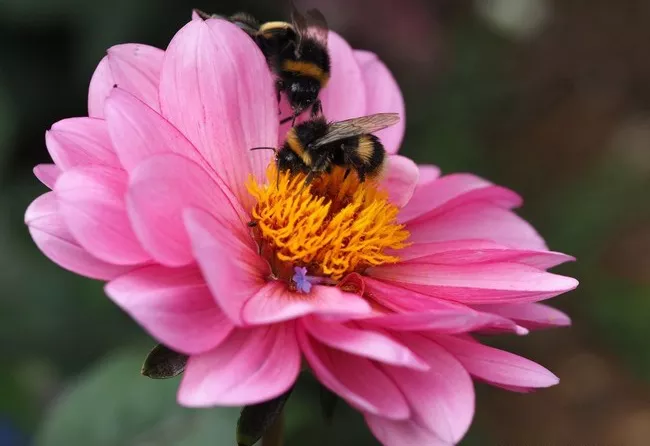Bees and butterflies play crucial roles in pollination, ensuring the reproduction of many plants, including those we rely on for food. By planting flowers that attract these pollinators, you support biodiversity and enhance the health of your garden. Choosing the right flowers not only benefits the environment but also brings vibrant color and life to your garden.
Characteristics of Pollinator-Friendly Flowers
Nectar-Rich and Pollen-Rich Flowers
Flowers that produce abundant nectar and pollen are essential for attracting bees and butterflies. Nectar provides energy, while pollen is a source of protein for bees. Plants like lavender, sunflowers, and zinnias are excellent choices because they offer these resources in abundance.
Bright Colors and Pleasant Scents
Bees are drawn to flowers in shades of blue, purple, and yellow, while butterflies prefer bright colors like red, orange, and pink. Scent also plays a significant role; flowers with strong, sweet fragrances, such as lavender and honeysuckle, are particularly attractive to pollinators.
Simple Flower Structures
Simple, open flowers are easier for bees and butterflies to access than complex, multi-layered blooms. Flowers like daisies, coneflowers, and marigolds, with their open petals and accessible nectar, are ideal for pollinators.
Top Flowers for Attracting Bees and Butterflies
Lavender (Lavandula)
Lavender is a top choice for attracting bees and butterflies. Its fragrant, purple flowers are rich in nectar, making it a favorite among pollinators. Lavender is also a hardy plant that thrives in sunny locations and well-drained soil. It’s drought-tolerant and low-maintenance, making it an easy addition to any garden.
Sunflowers (Helianthus annuus)
Sunflowers are not only visually striking but also highly attractive to bees and butterflies. Their large, open blooms provide easy access to nectar and pollen. Sunflowers grow best in full sun and well-drained soil, and they can reach impressive heights, adding a dramatic element to your garden.
Coneflowers (Echinacea)
Coneflowers are known for their vibrant colors and sturdy blooms. They are particularly attractive to butterflies, thanks to their large, daisy-like flowers. Coneflowers are drought-tolerant and thrive in sunny locations with well-drained soil. They also bloom for an extended period, providing a reliable source of nectar throughout the summer.
Zinnias (Zinnia elegans)
Zinnias are bright, cheerful flowers that attract a wide variety of pollinators, especially butterflies. They are easy to grow from seed and thrive in sunny spots with well-drained soil. Zinnias bloom from summer to fall, providing a continuous supply of nectar for pollinators.
Bee Balm (Monarda)
Bee balm is a favorite among bees, butterflies, and hummingbirds. Its tubular flowers are rich in nectar and come in vibrant shades of red, pink, and purple. Bee balm prefers moist, well-drained soil and can tolerate partial shade. It also has a pleasant, minty fragrance that adds another layer of appeal to your garden.
Salvia (Salvia spp.)
Salvia is a versatile plant with a wide range of colors and forms. Its tubular flowers are particularly attractive to hummingbirds and butterflies. Salvia is drought-tolerant and grows well in full sun and well-drained soil. It’s also a low-maintenance plant, making it an excellent choice for busy gardeners.
Butterfly Bush (Buddleja davidii)
As its name suggests, the butterfly bush is highly attractive to butterflies. Its long, fragrant flower spikes are filled with nectar, making it a magnet for pollinators. Butterfly bush grows best in full sun and well-drained soil. It’s a fast-growing shrub that can become quite large, so regular pruning may be necessary to keep it in check.
See Also: What Type of Flowers Attract Butterflies?
Creating a Pollinator-Friendly Garden
Grouping Flowers Together
Planting flowers in groups rather than scattering them individually makes it easier for bees and butterflies to find them. Grouping similar flowers together also creates a more visually striking display, enhancing the overall beauty of your garden.
Ensuring Continuous Blooming
To attract bees and butterflies throughout the growing season, plant a variety of flowers that bloom at different times. Early bloomers like crocuses can provide nectar in the spring, while late bloomers like asters extend the flowering season into the fall.
Avoiding Chemical Pesticides
Pesticides can be harmful to bees and butterflies, so it’s important to use natural pest control methods whenever possible. Organic pesticides can be a safer alternative, but they should still be used sparingly and carefully.
Providing Water Sources
Bees and butterflies need water, especially during hot weather. A shallow dish filled with pebbles and water or a small birdbath can serve as a water source for pollinators. Place it near your flowering plants to make it easy for bees and butterflies to hydrate while they feed.
Benefits of Attracting Pollinators
Attracting bees and butterflies to your garden has numerous benefits. These pollinators help ensure the health of your plants by aiding in pollination, leading to more abundant and healthier fruits, vegetables, and flowers. A garden full of bees and butterflies is also a vibrant, lively space that can provide endless enjoyment for you and your family.
Conclusion
Creating a garden that attracts bees and butterflies is a rewarding endeavor. By planting flowers like lavender, sunflowers, coneflowers, zinnias, bee balm, salvia, and butterfly bush, you can create a vibrant and pollinator-friendly space. Remember to group flowers together, ensure continuous blooming, avoid harmful chemicals, and provide water sources to create an environment that supports these essential creatures. With the right flowers and care, your garden can become a thriving habitat for bees, butterflies, and other beneficial pollinators.


